Related Research Articles

The Hebrew calendar, also called the Jewish calendar, is a lunisolar calendar used today for Jewish religious observance, and as an official calendar of the state of Israel. It determines the dates for Jewish holidays and the appropriate public reading of Torah portions, yahrzeits, and daily Psalm readings, among many ceremonial uses. In Israel, it is used for religious purposes, provides a time frame for agriculture, and is an official calendar for civil holidays, alongside the Gregorian calendar.

Nisan in the Babylonian and Hebrew calendars is the month of the barley ripening and first month of spring. The name of the month is an Akkadian language borrowing, although ultimately originates in Sumerian nisag "first fruits". In the Hebrew calendar it is the first month of the ecclesiastical year, called the "first of the months of the year", "first month", and the month of Aviv בְּחֹ֖דֶשׁ הָאָבִֽיב ḥōḏeš hā-’āḇîḇ). It is called Nisan in the Book of Esther in the Tanakh and later in the Talmud, which calls it the "New Year", Rosh HaShana, for kings and pilgrimages. It is a month of 30 days. In the year 2023, 1 Nisan will occur on 23 March. Counting from 1 Tishrei, the civil new year, it would be the seventh month, but in contemporary Jewish culture, both months are viewed as the first and seventh simultaneously, and are referred to as one or the other depending on the specific religious aspects being discussed.

Adar is the sixth month of the civil year and the twelfth month of the religious year on the Hebrew calendar, roughly corresponding to the month of March in the Gregorian calendar. It is a month of 29 days.
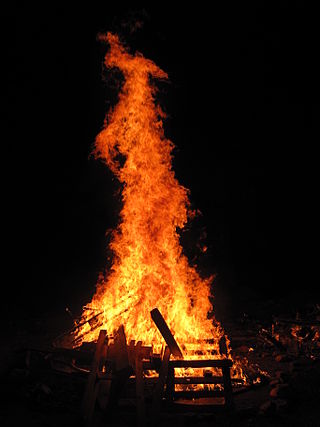
Iyar is the eighth month of the civil year and the second month of the Jewish religious year on the Hebrew calendar. The name is Babylonian in origin. It is a month of 29 days. Iyar usually falls in April–May on the Gregorian calendar.

Tishrei or Tishri is the first month of the civil year and the seventh month of the ecclesiastical year in the Hebrew calendar. The name of the month is Babylonian. It is a month of 30 days. Tishrei usually occurs in September–October on the Gregorian calendar.

Marcheshvan, sometimes shortened to Cheshvan, is the second month of the civil year, and the eighth month of the ecclesiastical year on the Hebrew calendar.
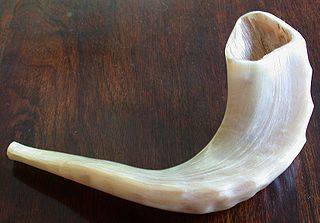
Elul is the twelfth month of the Jewish civil year and the sixth month of the ecclesiastical year on the Hebrew calendar. It is a month of 29 days. Elul usually occurs in August–September on the Gregorian calendar.

Jeconiah, also known as Coniah and as Jehoiachin, was the nineteenth and penultimate king of Judah who was dethroned by the King of Babylon, Nebuchadnezzar II in the 6th century BCE and was taken into captivity. He was the son and successor of King Jehoiakim, and the grandson of King Josiah. Most of what is known about Jeconiah is found in the Hebrew Bible. Records of Jeconiah's existence have been found in Iraq, such as the Jehoiachin's Rations Tablets. These tablets were excavated near the Ishtar Gate in Babylon and have been dated to c. 592 BCE. Written in cuneiform, they mention Jeconiah and his five sons as recipients of food rations in Babylon.
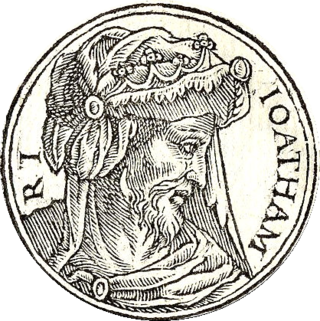
Jotham or Yotam was the eleventh king of Judah, and son of King Uzziah and Jerusha, daughter of Zadok. Jotham was 25 years old when he began his reign, and he reigned for 16 years. Edwin R. Thiele concluded that his reign commenced as a coregency with his father, which lasted for 11 years. Because his father Uzziah was afflicted with tzaraath after he went into the Temple to burn incense, Jotham became governor of the palace and the land at that time, i.e. coregent, while his father lived in a separate house as a leper.
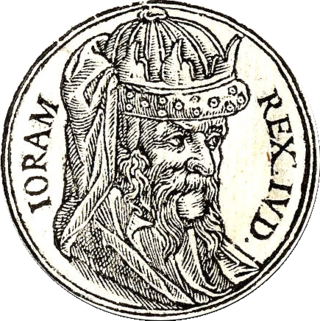
Jehoram of Judah or Joram, was the fifth king of Judah, and the son of king Jehoshaphat. Jehoram rose to the throne at the age of 32 and reigned for 8 years, although he was ill during his last two years.
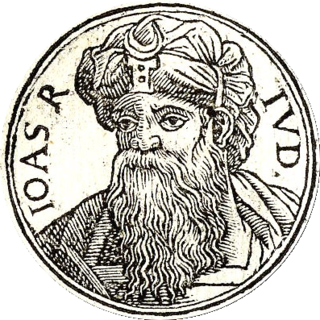
Jehoash, also known as Joash, Joas or Joás, was the eighth king of Judah, and the sole surviving son of Ahaziah after the massacre of the royal family ordered by his grandmother, Athaliah. His mother was Zibiah of Beersheba. Jehoash was 7 years old when his reign began, and he reigned for 40 years. He was succeeded by his son, Amaziah of Judah. He is said to have been righteous "all the days of Jehoiada the priest" but to have deviated from fidelity to Yahweh after Jehoiada's death.

Ahaziah of Judah or Jehoahaz I, was the sixth king of Judah, and the son of Jehoram and Athaliah, the daughter of king Ahab of Israel. He was also the first Judahite king to be descended from both the House of David and the House of Omri, through his mother and successor, Athaliah.
Tenth of Tevet, the tenth day of the Hebrew month of Tevet, is a fast day in Judaism. It is one of the minor fasts observed from before dawn to nightfall. The fasting is in mourning of the siege of Jerusalem by Nebuchadnezzar II of Babylonia—an event that began on that date and ultimately culminated in the destruction of Solomon's Temple, downfall of the Kingdom of Judah, and the Babylonian exile of the Jewish people.
The Fast of Gedalia, also transliterated from the Hebrew language as Gedaliah or Gedalya(h), is a minor Jewish fast day from dawn until dusk to lament the assassination of Gedaliah, the righteous governor of what was the Kingdom of Judah. His death ended Jewish autonomy following the destruction of the First Temple and the fall of King Zedekiah.

Birkat Hachama refers to a rare Jewish blessing that is recited to the Creator, thanking God for creating the sun. The blessing is recited when the sun completes its cycle every 28 years on a Tuesday at sundown. Jewish tradition says that when the Sun completes this cycle, it has returned to its position when the world was created. Because the blessing needs to be said when the sun is visible, the blessing is postponed to the following day, on Wednesday morning.

The Kings of Judah were the monarchs who ruled over the ancient Kingdom of Judah. According to the biblical account, this kingdom was founded after the death of Saul, when the tribe of Judah elevated David to rule over it. After seven years, David became king of a reunited Kingdom of Israel. However, in about 930 BCE the united kingdom split, with ten of the twelve Tribes of Israel rejecting Solomon's son Rehoboam as their king. The tribes of Judah and Benjamin remained loyal to Rehoboam, and re-formed the Kingdom of Judah, while the other entity continued to be called the Kingdom of Israel, or just Israel.

The siege of Jerusalem was the final event of the Judahite revolts against Babylon, in which Nebuchadnezzar II, king of the Neo-Babylonian Empire, besieged Jerusalem, the capital city of the Kingdom of Judah. Jerusalem fell after a 30-month siege, following which the Babylonians systematically destroyed the city and the First Temple. The Kingdom of Judah was dissolved and many of its inhabitants were exiled to Babylon.

Rosh HaShanah is the Jewish New Year. The biblical name for this holiday is Yom Teruah It is the first of the Jewish High Holy Days, as specified by Leviticus 23:23–25, that occur in the late summer/early autumn of the Northern Hemisphere. Rosh Hashanah begins a ten-day period of penitence culminating in Yom Kippur, as well as beginning the cycle of autumnal religious festivals running through Sukkot and ending in Shemini Atzeret.
Nisan-years is an ancient calendar system used around Mesopotamia. Its beginning was from the prehistorical era. Ever since Mesopotamia had historical writings, even before the First Babylonian dynasty of Hammurabi, its calendar used the Nisan-years.
Yom tov sheni shel galuyot, also called in short yom tov sheni, means "the second festival day in the Diaspora", and is an important concept in halakha. The concept refers to the observance of an extra day of Jewish holidays outside of the Land of Israel.
References
- ↑ Edwin R. Thiele, The Mysterious Numbers of the Hebrew Kings, rev. ed. (Grand Rapids: Kregal Publications).
- ↑ Finegan, Jack. Handbook of Biblical Chronology. Peabody MA: Hendrickson. pp. 25–42. ISBN 9781619706415.
- ↑ A. O. Scheffler and P. P. Scheffler, Calmaster2000: Dates, Holidays, Astronomical Events (Pittsburgh, PA: Zephyr Services).